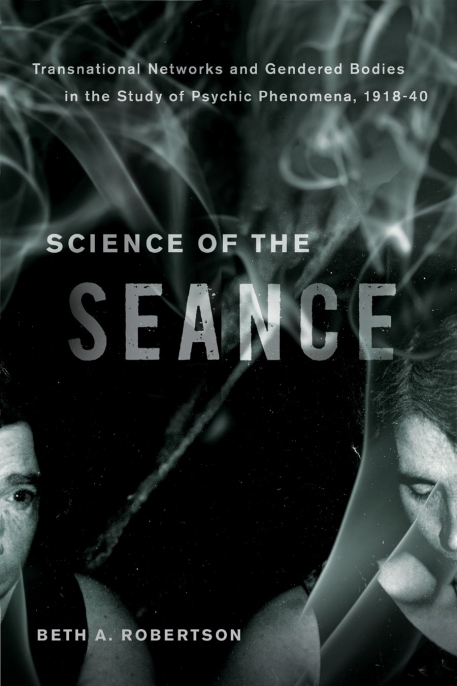
Reviewed by Tom Ruffles
While there has been considerable academic interest in Victorian Spiritualism and séance room phenomena over the past couple of decades, the period 1918-1939 has been less well served. Beth Robertson’s Science of the Seance helps to redress that imbalance. It is a shortened version of her 2013 history PhD awarded by Carleton University, Ottawa, and the prose style occasionally bears the marks of its academic origins.
Robertson argues that during the inter-war period changes took place in the séance room that echoed those in the wider society. The séance room was not a sealed space subject only to its own laws, but in different ways affirmed and transgressed norms, and as such presents a means to illuminate broader societal currents. There was a move from local to transnational networks of researchers, particularly linking Britain, Canada and the United States, reflecting increased movement of people and ideas. International links had always existed within Spiritualism, including transatlantic crossings by mediums, but became stronger thanks to improved communications, greater opportunities for travel, and a proliferation of organisations publishing information. This was part of a transnational trend in culture and politics more generally.
Unfortunately, while promising to cover British mediumship, Robertson’s focus is firmly on North American sources. One noticeable omission from a British perspective is Harry Price, only mentioned in passing, though he had strong international contacts, and was ‘Foreign Research Officer’ for the American Society for Psychical Research. The Society for Psychical Research in London is mentioned only a handful of times.
Instead, Robertson focuses primarily on the ‘Margery’ mediumship of Canadian-born Mina Crandon in Boston, Mass., and the work done by Thomas Glendenning Hamilton’s group in Winnipeg, Manitoba. There were links between the two, not least in the form of a spirit, Walter, who in life had been Mina’s brother; ‘he’ appeared at both locations, as well as the Spiritualist retreat in Lily Dale, New York.
In analysing the ‘gendered bodies’ of mediums, the other part of her subtitle, Robertson notes that male dominance was an aspect of mainstream science which psychical research emulated. Female mediums – often working class – were subjected to the middle- and upper-class male gaze and treated as little more than pieces of equipment. This approach signalled investigators’ attempts to remove the taint of subjectivity, considered a feminine attribute, in their endeavours to present themselves as sole experts despite not necessarily being as detached as they pretended.
The idea of the objective quasi-professional psychical researcher attempting to put the séance on a firm scientific footing as a means of establishing its legitimacy was not new, as technology had been applied to document mediumship for decades. What was new in the 1920s was the awareness of scientific developments which called previous certainties into question and expanded the language available to describe the supposed relationship between spirit and matter.
However, despite efforts to project psychical investigations as scientifically legitimate and producing strong evidence, the scientific establishment was in general left unmoved. Further, undermining their pose of control in the séance room, Robertson highlights a tendency for investigators to sometimes lose control of the process to assertive mediums and even spirits (Walter was keen on directing a programme of research from the other side, but of course he was essentially one of the boys). The result, Robertson suggests, was a blurring of the line demarcating the expert and the object of study.
As is often the case with academic writers on Spiritualism and psychical research, Robertson writes not as an insider but as “a historian of gender, science, medicine, and technology”. A rough guide to an author’s familiarity with the history of psychical research is the ‘Myers test’ – whether F W H Myers’ first name is spelled Frederic (correct) or Frederick (incorrect). It is a test Robertson fails, implying lack of close familiarity with a key figure in the field, one whose influence, as she notes, was still strong in the inter-war period. As a result of this limitation there is a failure to broaden the discussion sufficiently beyond the specific examples on which she concentrates.
On the evidence Robertson presents, there were fewer differences between the séance in the 1920s and ‘30s and its earlier incarnations than there were similarities. She fails to convince that there was a ‘radical shift’ after the Great War from traditional séance room to ‘psychical laboratory’. Even so, she provides a useful introduction to some of the work being done to explore the boundary between this world and the next in the period. Her book indicates the need for further exploration of the international networks of psychical research (especially in non-Anglophone countries) in this academically under-examined period.
An edited version of this review first appeared in Fortean Times, No. 363, February 2018, p. 56.

